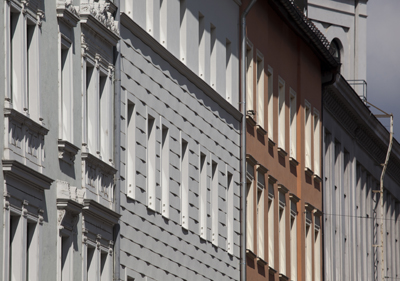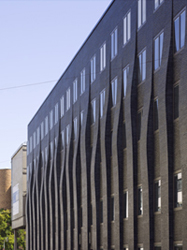You are in: Home page > Magazine > Gedacht / Gabaut
Gedacht / Gabaut
Architectural Appraisals

Andreas Hild

Intervention on the Reichenbachstraße, München 2010, Hild und K
When we speak about “building within the built” (Bauen im Bestand) essentially we must distinguish two meanings. On the one hand, the “built” as everything that has been constructed; the city, the site, the building, material pre-existences in the widest sense. On the other, the built of thinking, culture, memories, the idea of function or typology: the sum of the expectations that are then poured back into the work.
In this sense, making architecture is always a work in the built and around the built, and as such, the built is, in essence, more than just the physical substance of a building.
From this point of view, the built is always abounding in values. As a result, the crucial question consists in appraising this offer. This has to do with the choice of which built to rework and which to underscore, and more in general, how to classify interventions in the built. It becomes clear that the act of building subjects the already built and its conditions to a “constructive discourse”.
To be able to tackle this question, various “tales” have been woven over time to make a determined type of approach plausible, and hence viable. In different historical periods and in different ways these procedures have found major applications and thus it seems that each epoch has favoured its own to the extent of completely supplanting any other.
The Clean Sweep
The “tale” of “The Clean Sweep” is actually somewhat infrequent. But even if at the moment it seems to be taken into consideration only for certain particular cases, it has determined a great deal of the history of German architecture since the Second World War. This approach asserts that is capable of replacing an existing story with a new and better one, and in fact feels it a duty to do so. The absolute exigency upon which this tale must be founded to be practicable, makes it plausible only in certain exceptional cases.
Escape
Escape can prove valid as an architecturally correct “tale”. As in the classic case of the Athens Charter. As a principle, “Escape” arises from activating a further story alongside a preceding one, to allow a new unit to emerge from the contrast. The crucial point in this case is the “contrast”.
Contrast depends on the stories being distinguishable. This contrast is underscored to the point of religious and moralistic excess.
Reconstruction
Reconstruction presumes it possible to repeat a story or, even before that, that there are stories whose value is so extraordinary that it is worthwhile repeating them or at least assuming the responsibility of undertaking the repetition. That repetition is always an undertaking with materially uncertain outcomes is readily kept mum, also because Reconstruction always enjoys greater legitimation on the part of public opinion.
Continuing to Write
The debates of recent years revolve around the question of “The Clean Sweep” versus “Escape”.
Currently, an idea that can be defined as “Continuing to Write” (Weiterschreiben) is gaining favour in the debate.
This “Continuing to Write” denies the instant recognizability of the layers of time and institutes a sort of “fading”. A cross fading that blurs the margins of the story and is therefore a way that seeks to establish a fusion, that does not deny earlier history but at the same time believes it can form part of something new. In this sense, it is not very important where previous history ends and the new one begins, but what is important is the logic with which such unity is pursued. This behaviour inevitably leads to historical indeterminacy, which raises various questions. The most interesting thing is that the majority of these questions have a moral nature and revolve around legitimacy, honesty, authenticity, and similar concepts. It is almost never considered that this approach is the usual way with which buildings are transformed ‒ including a great deal of the Modernist period.
As an architect with a classical training, to be able to accept “Continuing to Write” as a possibility, it is therefore necessary to probe an entire series of seemingly incontestable presuppositions. If we leave aside for a moment the question of authorship, essentially the arguments against “Continuing to Write” are the idea that there is a looking backwards and a looking ahead and that therefore history is a linear process within which it is desirable to proceed towards the best.
This is understandable from a historian’s point of view and is probably the most sensible way of thinking; i.e. seeing history as a sequence of successive occurrences to be described one after another. As an architect, more occupied with production than classification, this linear approach seems of little use to me.
It limits the possibilities and thereby relegates architecture to one of three fundamental positions: to a more widespread behaviour described as innovative and forward-thinking that is always contrasted with a no less popular historicist backward-looking one, there appears to have been added a so-called contemporary spirit which is typically considered "fashionable".
Beyond this classification, in general it is difficult to maintain positions that deal in a different way with what history could be, or what history might potentially do.
The idea of “Continuing to Write” is not concerned with the question of whether it is legitimate to adopt a historical connection, or whether it is necessary to resort to so-called “innovation”. It focuses on its own internal logic and not on a linear classification.
Clearly, an approach of this type has enemies on all sides.
Some object to it as immoral because it does not abide by the current model of the linearity of time and the legitimacy deriving from it. Meanwhile, others, with regard to authorship, fear the loss of originality and the advantages linked to its distinguishability.
Presumably both worries are unfounded, inasmuch as “Continuing to Write” does not lead to either architecture without history, nor the loss of importance of its author. On the contrary, it opens up a hitherto little recognized field, that would notably enrich the number of possible approaches to our constructed, built and designed (Gebaut und Gedacht).
Andreas Hild (Hamburg 1961), architect, is head of the studio Hild und K Architekten of Munich along with Dionys Ottl. He has taught at various universities across Europe and the rest of the world. He has built important public and private works (Klostergarten St. Anna, 2003; Technical University of Munich, 2007-2012; buildings on the Reichenbachstraße, 2010).

Restoration of the building of the Technische Universitaet of Muenchen with a new facade, 2007 - 2012, Hild und K














